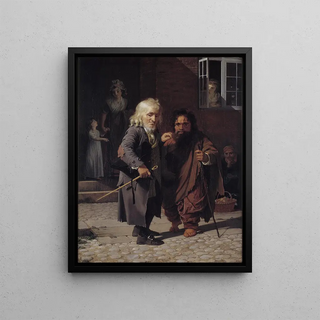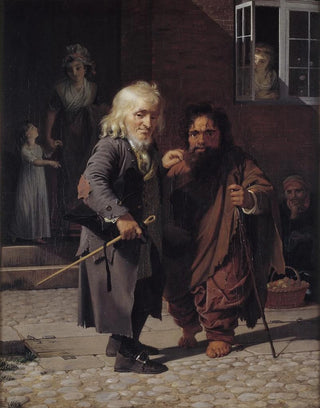Art print | Two dwarfs oblige a Jewish pigtail ribbon seller next to the Roman dwarf Bajocco in one of the streets of Copenhagen - Jens Juel


View from behind

Frame (optional)
In the fascinating panorama of 18th-century Danish art, Jens Juel's work stands out for its boldness and narrative depth. The art print of "Deux nains obligent un vendeur de rubans à queue de cochon juif à côté du nain romain Bajocco dans l'une des rues de Copenhague" offers a striking glimpse into the daily life of the period, while evoking universal themes such as marginality and social satire. Through this scene, Juel manages to capture not only the essence of his time but also to engage the viewer in a reflection on the power and class dynamics that traverse society. The piece unfolds like a living tableau, where each character, each detail, tells a story beyond mere representation.
Style and uniqueness of the work
Jens Juel's style is characterized by meticulous attention to detail and a delicate color palette that lends his works an atmosphere that is both realistic and poetic. In the art print of "Deux nains obligent un vendeur de rubans à queue de cochon juif à côté du nain romain Bajocco dans l'une des rues de Copenhague," the figures are depicted with an expressiveness that transcends their size. The dwarfs, often considered secondary characters in traditional art, take center stage here, symbolizing the often ignored voices of society. The dynamic composition, with a play of gazes and interactions between characters, creates a palpable tension that invites the viewer to question the motivations and desires of each. Juel succeeds in blending humor and social critique, making his work both accessible and deeply thoughtful.
The artist and his influence
Jens Juel, born in 1745, is an emblematic figure of Danish art, recognized for his ability to paint portraits and genre scenes that capture the spirit of his era. Trained at the Royal Danish Academy of Fine Arts in Copenhagen and influenced by European artistic currents, Juel developed a style that is uniquely his own, combining realism

Matte finish

View from behind

Frame (optional)
In the fascinating panorama of 18th-century Danish art, Jens Juel's work stands out for its boldness and narrative depth. The art print of "Deux nains obligent un vendeur de rubans à queue de cochon juif à côté du nain romain Bajocco dans l'une des rues de Copenhague" offers a striking glimpse into the daily life of the period, while evoking universal themes such as marginality and social satire. Through this scene, Juel manages to capture not only the essence of his time but also to engage the viewer in a reflection on the power and class dynamics that traverse society. The piece unfolds like a living tableau, where each character, each detail, tells a story beyond mere representation.
Style and uniqueness of the work
Jens Juel's style is characterized by meticulous attention to detail and a delicate color palette that lends his works an atmosphere that is both realistic and poetic. In the art print of "Deux nains obligent un vendeur de rubans à queue de cochon juif à côté du nain romain Bajocco dans l'une des rues de Copenhague," the figures are depicted with an expressiveness that transcends their size. The dwarfs, often considered secondary characters in traditional art, take center stage here, symbolizing the often ignored voices of society. The dynamic composition, with a play of gazes and interactions between characters, creates a palpable tension that invites the viewer to question the motivations and desires of each. Juel succeeds in blending humor and social critique, making his work both accessible and deeply thoughtful.
The artist and his influence
Jens Juel, born in 1745, is an emblematic figure of Danish art, recognized for his ability to paint portraits and genre scenes that capture the spirit of his era. Trained at the Royal Danish Academy of Fine Arts in Copenhagen and influenced by European artistic currents, Juel developed a style that is uniquely his own, combining realism






